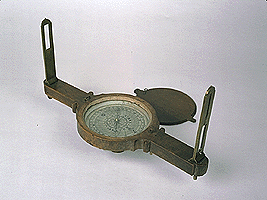 Fig. 66
Fig. 66
Signed: W. R. Dublin. fe. Latitude 53 20 * 1667 *
 Fig. 66
Fig. 66
A very early example of a circumferentor, perhaps the earliest known, that is also unusual in being Irish and in being made largely of wood. Wooden instruments were probably fairly common at the time, but have not survived well, and circumferentors were certainly more commonly used than something so complicated as an altazimuth theodolite. This rare survival is probably much more typical of useful, workaday instruments than the record of our collections would suggest.
The printed compass card follows Hopton's suggestion in combining a degree scale with a central sundial (see catalogue no. 47). He explained that a circumferentor could be used 'to plant barrels of powder, direct vnder Castles, Forts or such like'. Indeed the instrument became generally associated with mining, since the magnetic needle could be used for orientation underground, where no other sights were possible.
In a poetic preface to the Topographicall Glasse, Hopton includes among his potential readers and users those who:
Length: 350 mm
Inventory no. 33,340